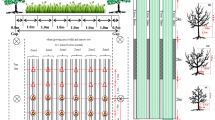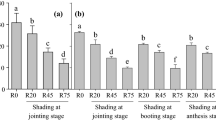Abstract
Effects of tree shading on crops within an agroforestry system in Hetian oasis regions in northwestern China are poorly understood. Measurements of light intensity, light use efficiency (LUE), light extinction coefficient, leaf area index (LAI), crop yield and biomass were studied in determining the effects of tree shading on crop yield in a jujube (Zizyphus jujuba Mill.)/wheat (Triticum aestivum L.) intercropping system. The treatments comprised (1) sole-cropped wheat, (2) 6-year-old sole jujube trees, (3) 8-year-old sole jujube trees, (4) 10-year-old sole jujube trees, (5) intercropping of wheat/6-year-old jujube trees, (6) intercropping of wheat/8-year-old jujube trees and (7) intercropping of wheat/10-year-old jujube trees. We found that the land equivalent ratios (LERs) of all three jujube tree/wheat treatments were larger than one and this indicated that plant growth factors were used more efficiently by the intercrop than by sole crops and the land use advantages of the intercropping systems were significantly greater than monoculture crops. Because of shading by trees, there was a decrease in intercropped wheat LAI, growth and yield, and the fruit yield of the intercropped jujube trees also decreased to a certain degree. The light interception of intercropped wheat was significantly decreased by different tree ages up to a certain point. The LUE results ranged from 1.68 to 1.31 and 1.13 g DM MJ [photosynthetically active radiation (PAR)]−1, indicating that LUE can be significantly affected by increasing tree age. Compared to intercropping 8-year-old jujube trees, a higher light extinction coefficient was found in intercropping 6- and 10-year-old jujube trees.
Similar content being viewed by others
References
Ares A, Brauer D (2004) Growth and nut production of black walnut in relation to site, tree type and stand conditions in south-central United States. Agrofor Syst 63:83–90
Awal MA, Koshi H, Ikeda T (2006) Radiation interception and use by maize/peanut intercrop canopy. Agric For Meteorol 139:74–83
Bayala J, Sileshi GW, Coe R, Kalinganire A, Tchoundjeu Z, Sinclair F, Garrity D (2012) Cereal yield response to conservation agriculture practices in dry lands of West Africa: a quantitative synthesis. J Arid Environ 78:13–25
Bertin C, Yang X, Weston LA (2003) The role of root exudates and allelochemicals in the rhizosphere. Plant Soil 256:67–83
Bohanek JR, Groninger JW (2005) Productivity of European black alder (Alnus glutinosa) interplanted with black walnut (Juglans nigra) in Illinois, USA. Agrofor Syst 64:99–106
Brenner AJ (1996) Microclimatic modifications in agroforestry. In: Ong CK, Huxley P (eds) Tree-crop interactions: a physiological approach. CAB International, Wallingford, pp 159–187
Cannell MGR, Van Noordwijk M, Ong CK (1996) The central agroforestry hypothesis: the tree must acquire resources that the crop would not otherwise acquire. Agofor Syst 34:27–31
Cao FL, Kimmins JP, Wang JR (2012) Competitive interactions in Ginkgo and crop species mixed agroforestry systems in Jiangsu, China. Agroforest Syst 84:401–415
Chirko CP, Gold MA, Nguyen PV, Jiang JP (1996) Influence of direction and distance from trees on wheat yield and photosynthetic photon flux density (Qp) in a Paulownia and wheat intercropping system. For Ecol Manag 83:171–180
Dale JE (1982) The growth of leaves. Studies in biology no. 137. Edward Arnold, London
Dhima KV, Lithourgidis AS, Vasilakoglou LB, Dordsas CA (2007) Competition indices of common vetch and cereal intercrops in two seeding ratio. Field Crop Res 100:249–256
Ding SS, Su PX (2010) Effects of tree shading on maize crop within a poplar-maize compound system in Hexi Corridor oasis, northwestern China. Agrofor Syst 80:117–129
Dufour L, Metay A, Talbot G, Dupraz C (2013) Assessing light competition for cereal production in temperate agroforestry systems using experimentation and crop modeling. J Agro Crop Sci 199:217–227
Frazer GW, Canham CD, Lertzman KP (1999) Gap light analyzer (GLA), Version 2.0: imaging soft ware to extract canopy structure and gap light transmission indices from true-colour fisheye photographs, users manual and program documentation. The Institute of Ecosystem Studies, Millbrook, NY
Friday JB, Fownes JH (2002) Competition for light between hedgerows and maize in an alley cropping system in Hawaii, USA. Agrofor Syst 55:125–137
Gao Y, Duan AW, Qiu XQ, Sun JS, Zhang JP, Liu H, Wang HZ (2010) Distribution and use efficiency of photosynthetically active radiation in strip intercropping of maize and soybean. Agro J 102:1149–1157
Goudriaan J (1977) Crop micrometerorology: a simulation study. Simulation monographs. PUDOC, Wageningen, p 249
Greb BW, Black AL (1961) Effects of windbreak plantings on adjacent crops. J Soil Water Conserv 16:223–227
Gruenewalda H, Brandt BKV, Schneider BU, Bens O, Kendziab G, Hüttl RF (2007) Agroforestry systems for the production of woody biomass for energy transformation purposes. Ecol Eng 29:319–328
Hauggaard-Nielsen H, Andersen MK, Jørnsgaard B, Jensen ES (2006) Density and relative frequency effects on competitive interactions and resource use in pea–barley intercrops. Field Crops Res 95:256–267
Jose S, Gillespie AR (1998a) Allelopathy in black walnut (Juglans nigra L.) alley cropping. I. Spatio-temporal variation in soil juglone in a black walnut-corn (Zea mays L.) alley cropping system in the midwestern USA. Plant Soil 203:191–197
Jose S, Gillespie AR (1998b) Allelopathy in black walnut (Juglans nigra L.) alley cropping. II. Effects of juglone on hydroponically grown corn (Zea mays L.) and soybean (Glycine max L. Merr.) growth and physiology. Plant Soil 203:199–205
Jose S, Gillespie AR, Seifert JR (2000) Defining competition vectors in a temperate alley cropping system in the Midwestern USA. 2. Competition for water. Agrofor Syst 48:41–49
Jose S, Gillespie AR, Seifert JR, Pope PE (2001) Comparison of minirhizotron and soil core methods for quantifying root biomass in a temperate alley cropping system. Agrofor Syst 52:161–181
Jose S, Gillespie AR, Pallardy SG (2004) Interspecific interactions in temperate agroforestry. Agrofor Syst 61:237–255
Li FD, Meng P, Dali F, Wang BP (2008) Light distribution, photosynthetic rate and yield in a Paulownia-wheat intercropping system in China. Agrofor Syst 74:163–172
Mao L, Zhang L, Zhao X, Liu S, van der Werf W, Zhang S, Spiertz H, Li Z (2014) Crop growth, light utilization and yield of relay intercropped cotton as affected by plant density and a plant growth regulator. Field Crops Res 155:67–76
Mead R, Willey RW (1980) The concept of a land equivalent ratio and advantages in yields from intercropping. Exp Agric 16:217–228
Monteith JL (1994) Validity and utility of the correlation between intercepted radiation and biomass. Agric For Meteorol 68:213–220
Monteith JL, Ong CK, Corlett JE (1991) Microclimate interactions in agroforestry systems. For Ecol Manag 45:31–44
Ong CK, Huxley P (1996) Tree-crop interactions: a physiological approach. CAB International, Wallingford, p 386
Raddad EY, Luukkanen O (2007) The influence of different Acacia senegal agroforestry systems on soil water and crop yields in clay soils of the Blue Nile region, Sudan. Agric Water Manag 87:61–72
Rao MR, Sharma MM, Ong CK (1990) A study of the potential of hedge row intercropping in semi-arid India using a 2-way systematic design. Agrofor Syst 11:243–258
Rao MR, Sharma MM, Ong CK (1991) A tree-crop interface design and its use for evaluating the potential of hedge row intercropping. Agrofor Syst 13:143–158
Reynolds MP, Pellegrineschi A, Skovmand B (2005) Sink-limitation to yield and biomass: a summary of some investigations in spring wheat. Ann Appl Biol 146:39–49
Rivest D, Cogliastro A, Vanasse A, Olivier A (2009) Production of soybean associated with different hybrid poplar clones in a tree-based intercropping system in southwestern Quebec. Can Agri Ecosyst Environ 131:51–60
Rivest D, Cogliastro A, Bradley RL, Olivier A (2010) Intercropping hybrid poplar with soybean increases soil microbial biomass, mineral N supply and tree growth. Agrofor Syst 80:33–40
Schroth G (1999) A review of belowground interactions in agroforestry, focussing on mechanisms and management options. Agrofor Syst 43:5–34
Singh RP, Ong CK, Saharan N (1989) Above and below ground interactions in alleycropping in semi-arid India. Agrofor Syst 9:259–274
Tsubo M, Walker S, Mukhala E (2001) Comparisons of radiation use efficiency of mono-/inter-cropping systems with different row orientations. Field Crops Res 71:17–29
van Asten PJA, Wairegi LWI, Mukasa D, Uringi NO (2011) Agronomic and economic benefits of coffee–banana intercropping in Uganda’s smallholder farming systems. Agric Syst 104:326–334
Vandermeet J (1989) The ecology of intercropping. Cambridge University Press, New York
Wang YP, Jarvis PG (1990) Influence of crown structural properties on PAR absorption, photosynthesis and transpiration in Sitka spruce: application of a model (MAESTRO). Tree Physiol 7:297–316
Wang BJ, Zhang W, Ahanbieke P, Gan YW, Xu WL, Li LH, Christie P, Li L (2014) Interspecific interactions alter root length density, root diameter and specific root length in jujube/wheat agroforestry systems. Agrofor Syst 88:835–850
Yang LL, Ding XQ, Liu XJ, Li PM, Egrinya Eneji A (2016) Impacts of long-term jujube tree/winter wheat–summer maize intercropping on soil fertility and economic efficiency—a case study in the lower North China Plain. Eur J Agron 75:105–117
Yin R, He Q (1997) The spatial and temporal effects of Paulownia intercropping: the case of northern China. Agrofor Syst 37:91–109
Zamora DS, Jose S, Nair PKR, Ramsey CL (2006) Interspecific competition in a pecan-cotton alleycropping system in the southern United States: production physiology. Can J Bot 84:1686–1694
Zamora DS, Jose S, Nair PKR (2007) Morphological plasticity of cotton roots in response to interspecific competition with pecan in an alley cropping system in the southern United States. Agrofor Syst 69:107–116
Zhang L, van der Werf W, Bastiaans L, Zhang S, Li B, Spiertz JHJ (2008a) Light interception and utilization in relay intercrops of wheat and cotton. Field Crops Res 107:29–42
Zhang L, van der Werf W, Zhang S, Li B, Spiertz JHJ (2008b) Temperature mediated developmental delay may limit yield of cotton in relay intercrops with wheat. Field Crops Res 106:258–268
Zhang W, Ahanbieke P, Wang BJ, Xu WL, Li LH, Christie P, Li L (2013) Root distribution and interactions in jujube tree/wheat agroforestry system. Agrofor Syst 87:929–939
Zhang DS, Zhang LZ, Liu JG, Han S, Wang Q, Evers J, Liu J, van der Werfc W, Li L (2014) Plant density affects light interception and yield in cotton grown as companion crop in young jujube plantations. Field Crops Res 169:132–139
Zhang W, Ahanbieke P, Wang BJ, Gan YW, Li LH, Christie P, Li L (2015) Temporal and spatial distribution of roots as affected by interspecific interactions in a young walnut/wheat alley cropping system in northwest China. Agrofor Syst 89:327–343
Zhang W, Wang BJ, Gan YW, Duan ZP, Hao XD, Xu WL, Lv X, Li LH (2017) Competitive interaction in a jujube tree/wheat agroforestry system in northwest China’s Xinjiang Province. Agrofor syst 91(5):881–893
Zhou J, Wu YZ, Yan G (2005) General formula for estimation of monthly average daily global solar radiation in China. Energy Conv Manage 46:257–268
Acknowledgements
This work was financially supported by the NSFC (project no. 31460335 and 31560376), by the project funded by the China Postdoctoral Science Foundation (project no. 2015M582737), by the Chinese Ministry of Science and Technology (project no. 2009BADA4B03), by the Chinese Ministry of Agriculture (project no. 201003043-01), and by the Scientific Research Funds for High Calibre Researchers of Shihezi University (project no. RCZX201422).
Author information
Authors and Affiliations
Corresponding author
Rights and permissions
About this article
Cite this article
Zhang, W., Wang, B.J., Gan, Y.W. et al. Different tree age affects light competition and yield in wheat grown as a companion crop in jujube-wheat agroforestry. Agroforest Syst 93, 653–664 (2019). https://doi.org/10.1007/s10457-017-0160-z
Received:
Accepted:
Published:
Issue Date:
DOI: https://doi.org/10.1007/s10457-017-0160-z




